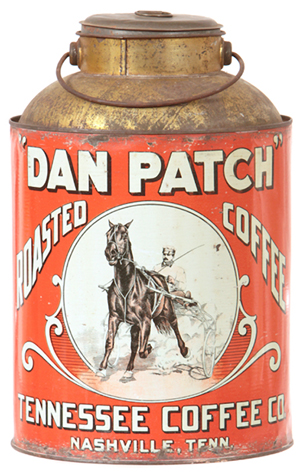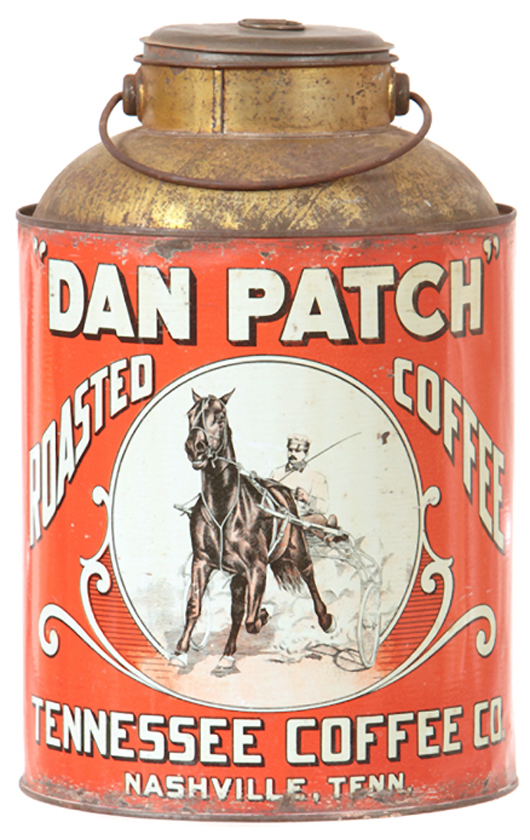
History becomes more interesting if you learn about it through objects and stories. It’s the “rest of the story” that adds to the fun.
A large pail that once held Dan Patch Roasted Coffee auctioned recently for $2,035. The bright-red can features a horse and driver in a harness race. The can is colorful, 11 1/2 inches tall and very decorative, but the price was boosted by the history it represents.
Dan Patch was a brown horse, a pacer, born in Indiana in 1896. He broke the world’s record for a harness race in 1906, and it took 32 years for another horse to go faster. He never lost a race. He was a celebrity, and coffee wasn’t the only product named for him. Automobiles and washing machines and cigars bore his name, and so did popular toys.
Crowds followed his appearances and as many as 100,000 people went to see the horse, which, according to reports, “radiated charisma.” Dan Patch received fan mail and gifts while making as much as $1 million in a year.
He retired from racing in 1909 and died in 1916. He remained a star for many years after his death, partly because his world record was not broken until 1938.
Streets named Dan Patch still exist. Dan Patch Stadium is at a high school in Savage, Minn., where the horse lived after he was purchased by a Minnesotan in 1902. An annual Dan Patch Day festival is celebrated in his hometown of Oxford, Ind., and another annual Dan Patch Day is held in Savage.
Books have been written about him, a movie was made about his life in 1949 and he’s mentioned in a song from the 1957 Broadway musical, The Music Man.
Dan Patch Ground Coffee was named for the horse well before the days of movies and television. You can still find Dan Patch memorabilia in Savage, Minn., today. Go to the Savage Depot Coffee Shop, the Razors Edge Barber Shop or the local library.
Q: I inherited two antique Mettlach steins that were appraised six years ago for $1,700 each. I have been trying to sell them online and locally for less than that, but I have gotten no takers. Some dealers have made insulting remarks about my pricing. What’s going on?
A: Some Mettlach steins in mint condition can sell for $1,700 or even more, but many sell for a lot less. Price depends on the rarity of a particular stein. In addition, you’re dealing with a niche market and may not be reaching interested buyers. Try contacting a national auction house that focuses on steins. You will find several online.
Q: My grandmother, who was born in 1886, left her favorite rocking chair to me. She lived in Chippewa Falls, Wis., and the chair is labeled “Webster Mfg. Co., Superior, Wis.” The chair is oak and has a pressed design in the back’s crest above six turned spindles. What can you tell me?
A: Webster Manufacturing Co. of Superior, Wis., was making chairs by the 1890s. In its early years, it was called the Webster Chair Co. By 1915 it was a major American chair manufacturer and had opened a factory in at least one other city. It appears to have gone out of business during the Depression. Pressed oak chairs like yours were especially popular in the late 19th century, so it is likely your chair dates from that period. Depending on its condition, it would sell for $100 or more.
Q: I have a kerosene lamp marked “Queen Anne” and “Scovill Mfg. Co.” I know it’s about 100 years old. Can you give me some information about it?
A: Scovill Manufacturing Co. opened in 1802 in Waterbury, Conn., under the name Abel Porter & Co. It made brass buttons and operated under various names and owners through the years. James Mitchell Lamson Scovill and William H. Scovill eventually took over the business, which was incorporated as Scovill Manufacturing Co. in 1850. Scovill made brass lamps, artillery fuses, munitions, medals, daguerreotype plates, cameras and other items. After 1866 it also made coin blanks for the U.S. Mint. Scovill holds several patents for improvements to lamp burners. “Queen Anne” is a type of burner that was in common use in the late 1800s. It was made by Scovill and other companies. New Queen Anne burners are available today for repair and restoration of old lamps. Scovill is still in business, with headquarters in Clarkesville, Ga. Today the company makes fasteners for clothing and light industrial use and holds a patent for the gripper snap, introduced in the 1930s. Your lamp was probably made in the late 1800s. If all parts are original, it is worth about $100 to $150.
Q: I have an item called a “motion teaser.” It includes five heavy silver balls about an inch in diameter. Each is attached to a string and the strings are attached to a wooden frame. You swing one ball so it touches the next one and then they all swing back and forth. However, it stops in about a minute. Aren’t they supposed to keep swinging back and forth by themselves? Every once in a while, I see one of these in an old movie and the balls keep swinging back and forth indefinitely. Am I doing something wrong? I don’t see what the big deal is if you have to start it every other minute. Someone gave me this. I think this it’s from the 1970s or ’80s.
A: Your toy was invented in 1967 by Simon Prebble, an English actor, and is known as “Newton’s Cradle” because it demonstrates one of Isaac Newton’s laws of motion: “For every action, there is an equal and opposite reaction.” When you pull the first ball back and release it so that it swings and hits the row of balls, the energy is transferred through the line of balls to the ball on the other end, causing it to swing out at approximately the same distance and back to hit the stationary balls. If you pull two balls out, two balls will swing out from the opposite end. It’s not a perpetual motion machine, because some momentum and energy are lost with each hit due to friction. The length of time it will keep going is based partly on how well it’s built. Toys like this were made under several names and in different sizes. They always have an odd number of balls, usually five or seven. Someone has even made Newton’s Cradle using 15-pound bowling balls hung from 20-foot cables.
Tip: An unglazed rim on the bottom of a plate usually indicates it was made before 1850.
Terry Kovel answers as many questions as possible through the column. By sending a letter with a question, you give full permission for use in the column or any other Kovel forum. Names, addresses or email addresses will not be published. We cannot guarantee the return of any photograph, but if a stamped envelope is included, we will try. The volume of mail makes personal answers or appraisals impossible. Write to Kovels, Auction Central News, King Features Syndicate, 300 W. 57th St., New York, NY 10019.
CURRENT PRICES
Current prices are recorded from antiques shows, flea markets, sales and auctions throughout the United States. Prices vary in different locations because of local economic conditions.
Shade pull, Mayflower ship, cast iron, original paint, double-sided, circa 1930s, 2 x 1 5/8 inches, $75.
Luncheon set, porcelain, rainbow luster, lakeside cottage, trees, white swan handles with gold leaf, plates, cups, saucers, teapot, sugar and creamer, service for four, $100.
Mickey Mouse pocket comb, black plastic, two-sided case, Mickey combing his hair on 1 side, Minnie holding comb on other, American Hard Rubber Co., 1930s, 5 inches, $115.
Girl Scout doll, hard plastic, auburn hair, uniform, Terri Lee Doll Co., 1952, 8 inches, $160.
Evening palazzo pants set, black pants, knife pleats, gold and white metallic brocade bodice, sleeveless, 1960s, 34 bust, 26 waist, $185.
Toy, dancing sailor, tin lithograph, blue shirt and pants, moves back and forth, Lehmann, Germany, 1903, 8 inches, $255.
Sign, Smith Brothers Cough Drops, easel back, image of three men dressed in heavy coats, another in underwear waving pennant, 1930s, 24 x 17 inches, $330.
Francie doll, Twist ‘n Turn, painted face, pierced ears, long black hair, Mattel, 1967, 11 inches, $450.
Egg serving set, glass, chicken-on-nest basket dish, six egg cups, basket-weave tray, Vallerysthal, France, signed, tray 11 inches, 10 pieces, $515.
Screen, Louis XV-style, three panels, carved fruitwood frame, padded and tufted inserts, reversible hinges, 1930s, 73 x 69 x 67 inches, $3,200.
New! The Kovels.com “Premium” offers are up and running. In addition to 750,000 free prices for antiques and collectibles, many with photographs, premium subscribers will find a dictionary of marks for silver and another for ceramics, with pictured marks and company histories. Premium membership also includes a subscription to the digital edition of our newsletter, “Kovels on Antiques and Collectibles,” and its archives, where you’ll find articles about almost anything you might collect. Up-to-date information for the savvy collector. Go to Kovels.com and click on “Subscriptions” for more information.
© 2012 by Cowles Syndicate Inc.
ADDITIONAL IMAGE OF NOTE


